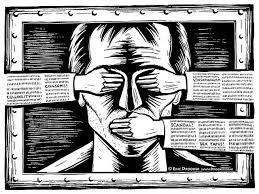To set the stage: last year, the Fifth Circuit Court of Appeals unanimously upheld a federal district court’s finding that the evidence likely established that the Biden Administration, including then spokesperson Jen Psaki, had engaged in a broad attack on free speech in violation of the First Amendment. It issued an injunction prohibiting the White House and other federal agencies from taking “actions, formal or informal, directly or indirectly, to coerce or significantly encourage social-media companies to remove, delete, suppress, or reduce… social-media content containing protected free speech.”
The government appealed to the Supreme Court, which stayed enforcement of the injunction, pending its review. The Court heard oral argument in March. The administration might prevail, despite browbeating social media into blocking core political speech, including criticism of Biden, humor, and discussion of the Hunter Biden laptop. Yes, that same laptop the Justice Department and FBI just admitted were legitimate and tamper-free. A decision is expected within 10 days.
Now, KJP and the administration are doubling down. Attacking a new category of “cheap fake” videos, KJP blasted the media for publishing unaltered video of the president’s frailties. Her objection appears to be that by presenting information about the president out of the context preferred by the administration, this video is, in effect, fake. See here.
While the administration was unclear about the missing context, I infer that it prefers a focus on the presumed majority of the president’s 10 AM to 4 pm, Monday-to-Friday workday during which he is not frozen, wandering aimlessly, mumbling incoherently, or blanking out. I understand that preference, but it is unseemly, and depending on next steps, may be unconstitutional, for a government official, speaking from the White House, to seek to chill free speech.
KJP claimed these videos are “misleading,” “manipulated” and “deep fakes.” A deep fake is false. But, what KJP really means is to falsely allege that the videos are out of context. As such, her attack has all the earmarks of the administration’s censorship campaign against “malinformation.” The administration defines three categories of speech it asserts should be censored, misinformation and disinformation, which include falsehoods, and “malinformation,” which is used out of context, specifically, truthful information that does not have a progressive spin.
Aside from the misinformation in KJP’s attack – the videos presented by mainstream media and respected conservative online publications are revealing, unedited windows into a physically and cognitively impaired president; they are neither out of a context necessary to understand what we are seeing, nor manipulated. Regardless, the White House press secretary (as contrasted to a campaign spokesperson), has no business demanding censorship of videos that paint the president in a bad light. Actions like this led two federal courts to issue injunctions against the White House.
The Supreme Court explained in W. Va. State Bd. of Educ. v. Barnette (1943) that “If there is any fixed star in our constitutional constellation, it is that no official, high or petty, can prescribe what shall be orthodox in politics, nationalism, religion, or other matters of opinion.” In Ashcroft v. ACLU (2002), the Court declared that with few exceptions, “the First Amendment means that government has no power to restrict expression because of its message, its ideas, its subject matter, or its content.”
Labeling speech as “misinformation” does not strip it of protection. In United States v. Alvarez (2012), Justice Anthony Kennedy explained that even “false statements” may not be censored, writing “some false statements are inevitable if there is to be an open and vigorous expression of views….Our constitutional tradition stands against the idea that we need Oceania’s Ministry of Truth.”
Speaking directly to KJP’s demands, Justice Kennedy added: “The mere potential for the exercise of that [censorship] power casts… a chill the First Amendment cannot permit if free speech, thought, and discourse are to remain a foundation of our freedom….The response to the unreasoned is the rational; to the uninformed, the enlightened; to the straight-out lie, the simple truth…Society has the right and civic duty to engage in open, dynamic, rational discourse. These ends are not well served when the government seeks to orchestrate public discussion through content-based mandates.”
It is irrelevant that the publishers or social media companies will be the instrument of suppression. As Justice Clarence Thomas summarized in 2021, “The government cannot accomplish through threats of adverse government action what the Constitution prohibits it from doing directly.”
The administration is afraid that voters will learn the truth. It is now up to a free media and the Republican candidate for president to make certain that voters know how to apply that fear.
Kenin M. Spivak is founder and chairman of SMI Group LLC, an international consulting firm and investment bank. He is the author of fiction and non-fiction books and a frequent speaker and contributor to media, including The American Mind, National Review, the National Association of Scholars, television, radio and podcasts. He received his A.B., M.B.A., and J.D. from Columbia University.






